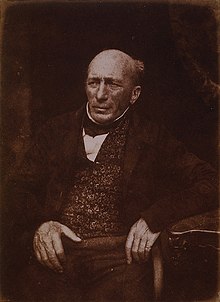Robert Barclay Allardice
Robert Barclay Allardice of Ury (born August 25, 1779 in Stonehaven , Kincardineshire , Scotland , † May 8, 1854 in London ), usually called Captain Barclay, was the most famous Scottish pedestrian of the early 19th century.
family
Captain Barclay's father was Robert Barclay, 5th of Ury (1732–1797), a member of an old Scottish family, great-grandson of Robert Barclay, 2nd of Ury (1648–1690), the founder of Barclays Bank , who was born with a descendant of the Scottish King Robert II . (Scotland) was married and therefore was allowed to have their name Allardice in the name. The family has always been considered athletic: The First Laird of Ury was one of the strongest men in the Highland Games at the time of the English Civil War , Robert Barclay Allardice Senior was a well-known pedestrian who walked from Ury to London (820 km) in ten days was. Robert Barclay jun. went to Richmond School and Cambridge University in England .
Major competitions
- In 1801, Captain Barclay walked 110 miles (177 km) in 19 h 27 minutes in a muddy park.
- In 1802 he walked 64 miles (103 km) in 10 hours.
- In 1805 he walked 72 miles (116 km) between breakfast and dinner.
- In 1806 he walked 100 miles (161 km) on bad roads in 19 hours.
- In 1807 he walked 78 miles (125 km) on hilly roads in 14 hours.
- From June 1st to July 12th 1809 on Newmarket Heath (illuminated circuit of ½ mile) he walked 1000 miles an hour for 1000 guineas (= £ 1050). His average speed decreased from 14:54 minutes to 21:04 minutes per mile. Barclay lost from 84.5 kg to 70 kg in that time. The over 10,000 viewers a day included u. a. the Prince of Wales .
Barclays training
Since galenic medicine dominated with the theory of juices , intensive sweating (sometimes with the consumption of alcohol) was required before the beginning of the training periods in order to get rid of body toxins. In addition, phosphates were consumed regularly . The daily training usually consisted of 32–40 km: before breakfast 800 m maximum, then 10 km walking / jogging. Breakfast: raw steak (or sheep meat), dry bread or rusks, stale non-carbonated beer. After breakfast another 10 km of walking / jogging. No lunch, 30 min sleeping / resting on your back. Then 6 km of fast walking. 4 p.m. Dinner and breakfast. After dinner 800 m maximum; then 10 km walking / jogging. Sleep at 8 p.m. Barclay trained under the experienced Yorkshire pedestrian John Smith and boxer Will Ward, so he did strength training in addition to endurance training . He was also successful in tree trunk throwing and hammer throwing . He is said to have lifted a man (115 kg) with one hand from the floor onto a table. Later he tried himself as a trainer by combining both training principles and favoring very large training volumes.
Military career
Since 1805, Captain Barclay was a member of the 23rd Infantry Regiment. Promoted to captain in 1806 and major in 1814, he retired from the military just two months after promotion. Only five days after his 1,000 miles he rejoined his regiment as adjutant to the commanding officer Marquess of Huntly and took part in the battle of Walcheren against Napoleon . He also tried to reorganize the physical training of soldiers according to his principles in order to counter the superior discipline and fitness of the Napoleonic armies.
Title dispute
Captain Barclay claimed the title of Earl of Airth , which according to his lawyers he should have inherited in the female line. In 1839 the House of Lords ruled against him. Had he got the title, he would also have been heir to the Kings of Scotland. Claims to inheritance of the titles of Earl of Menteith and Strathearn were then no longer pursued by him. Because Barclay had such a social status, pedestriantism, actually a sport for the poor, gained social importance, so that the long distances of athletics continued to be of interest to amateurs. Barcelay died in 1854 three days after being kicked by a horse. In 2002 he was inducted into the Scottish Sports Hall of Fame .
Individual evidence
- ^ Peter Radford : The Celebrated Captain Barclay: Sport, Money and Fame in Regency Britain . Headline, 2001, ISBN 978-0-7472-7222-9 .
- ↑ theguardian.com
- ^ Walter Thom: Pedestrianism . Chalmers and Company, Aberdeen 1813; library.la84.org (PDF)
- ^ PF Radford: From oral tradition to printed record: British sports science in transition, 1805-7 . In: Proceedings of the XIIth HISPA Congress (1987), pp. 295-304.
- ↑ englishhistoryauthors.blogspot.de
- ↑ Arnd Krüger : Many roads lead to Olympia. The changes in training systems for medium and long distance runners (1850–1997). In: N. Gissel (Hrsg.): Sporting performance in change . Czwalina, Hamburg 1998, pp. 41-56.
- ↑ Sporting News , cit. n. Stephen Bates: 1815: Regency Britain in the year of Waterloo . Head of Zeus, London, 2015; books.google.de
- ^ Allardice, Robert Barclay . In: Leslie Stephen (Ed.): Dictionary of National Biography . Volume 1: Abbadie - Anne. MacMillan & Co, Smith, Elder & Co., New York City / London 1885, pp 298 - 299 (English).
- ↑ sshf.co.uk
| personal data | |
|---|---|
| SURNAME | Allardice, Robert Barclay |
| ALTERNATIVE NAMES | Allardice of Ury, Robert Barclay (full name) |
| BRIEF DESCRIPTION | Scottish representative of pedetriantism |
| DATE OF BIRTH | August 25, 1779 |
| PLACE OF BIRTH | Stonehaven , Kincardineshire, Scotland |
| DATE OF DEATH | May 8, 1854 |
| Place of death | London |
